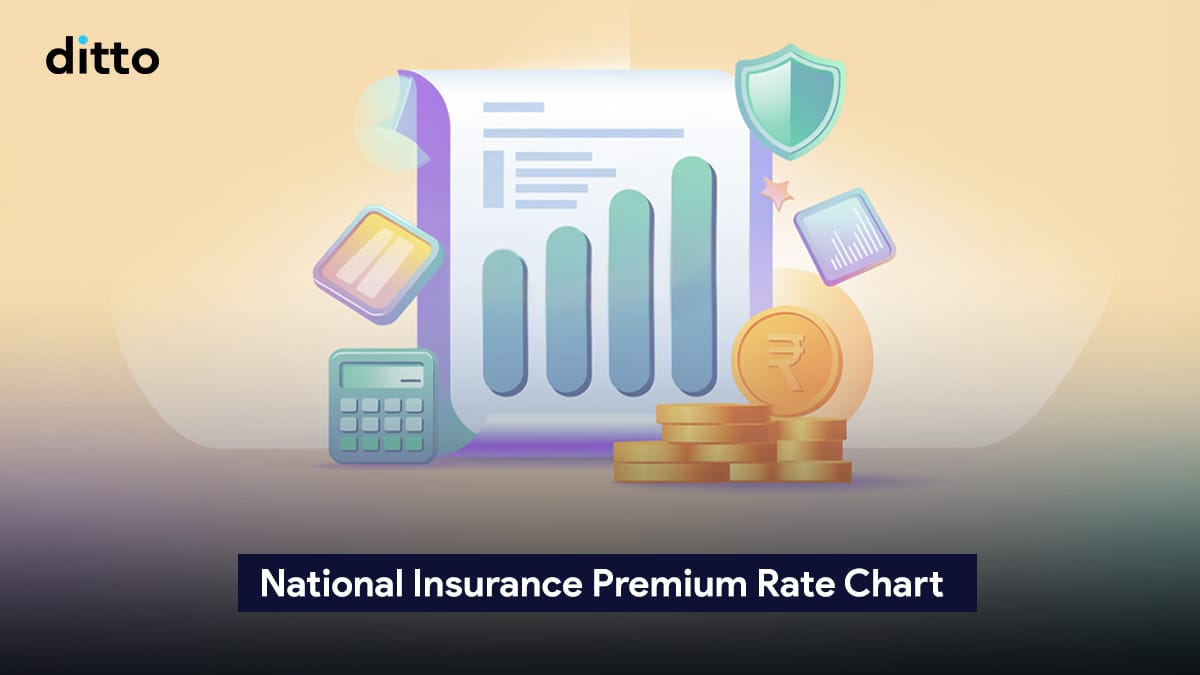| What is the National Insurance Premium Rate Chart? Each insurance company in India is required to submit a premium chart to IRDAI for transparency in pricing models and public accountability. The chart displays age bands, sum insured slabs, location/zones and other policy specifications. It is a standardized reference table that displays benchmark premium rates for various types of insurance products, including life, health, and motor insurance.The chart can be displayed as a static table in the brochure/website or presented through an online premium calculator. Similarly, the National Insurance (NICL) also publishes its premium rates for each of its insurance products to provide clarity and support informed decision-making for its customers. |
Ever noticed how your health insurance premiums differ from someone else’s, even for the same policy? That’s because several key factors, like age group, city of residence, and riders play a significant role in determining your final policy premium. These elements help insurers assess risk more accurately and price policies fairly. At Ditto, we help customers understand these differences and help them make informed choices for the best coverage.
This guide helps you understand:
- how the National Insurance Company calculates premiums.
- Covers age bands, sum insured slabs, and zonal classifications.
- Simplifies complex terms for easy understanding.
If you need help in learning more about the National Insurance Company in India, book a free consultation call with Ditto and our advisors will help you out.
Let’s take a look at some key Public Sector Undertaking (PSU) insurance companies in India:
| Company Name | Role |
|---|---|
| New India Assurance Company Limited (1919) | The largest government-owned general insurer offering motor, health, travel, and property insurance in India and abroad |
| United India Insurance Company Limited (1938) | Provides a wide range of non-life insurance products including motor, fire, and health coverage. |
| Oriental Insurance Company Limited (1947) | Offers diverse insurance plans such as accident, property, and health insurance. |
| National Insurance Company Limited (1906) | The oldest PSU general insurer with a strong presence across India, covering multiple non-life segments |
Check out this video to know more about public health plans in India 2025:
National Insurance Premium Rate Chart: Age Bands & Sum Insured Slabs
Here’s a snippet from National Mediclaim policy where you can find the Rate chart:
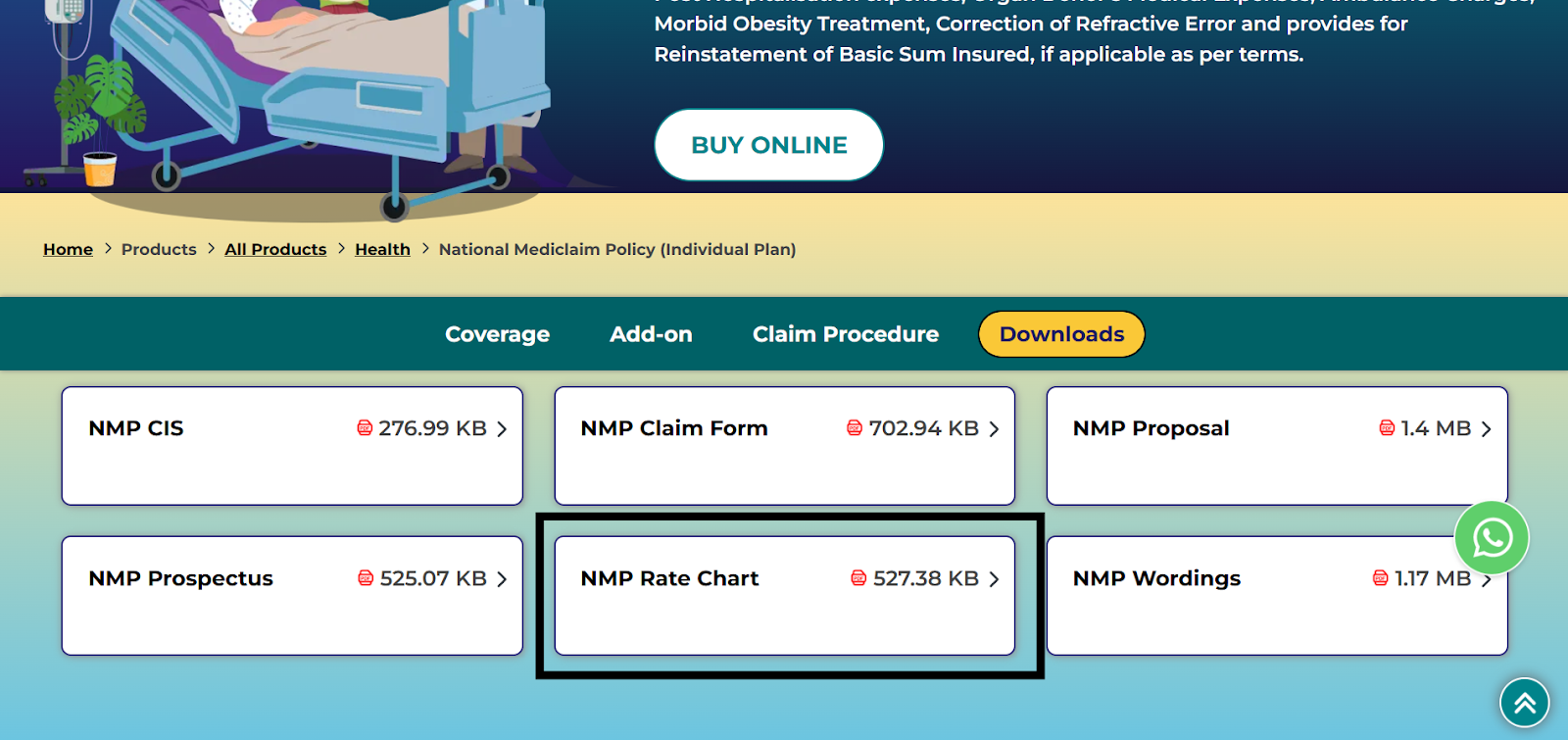
Age Bands and Sum Insured Slabs provide standardized categories for risk assessment and premium calculation. Age bands group policyholders by age ranges, while sum insured slabs define coverage levels.
Such classifications are required because age affects health risk, life expectancy, and the likelihood of claims, while the sum insured indicates potential payout exposure.
Here’s a snippet from National Insurance’s National mediclaim policy:
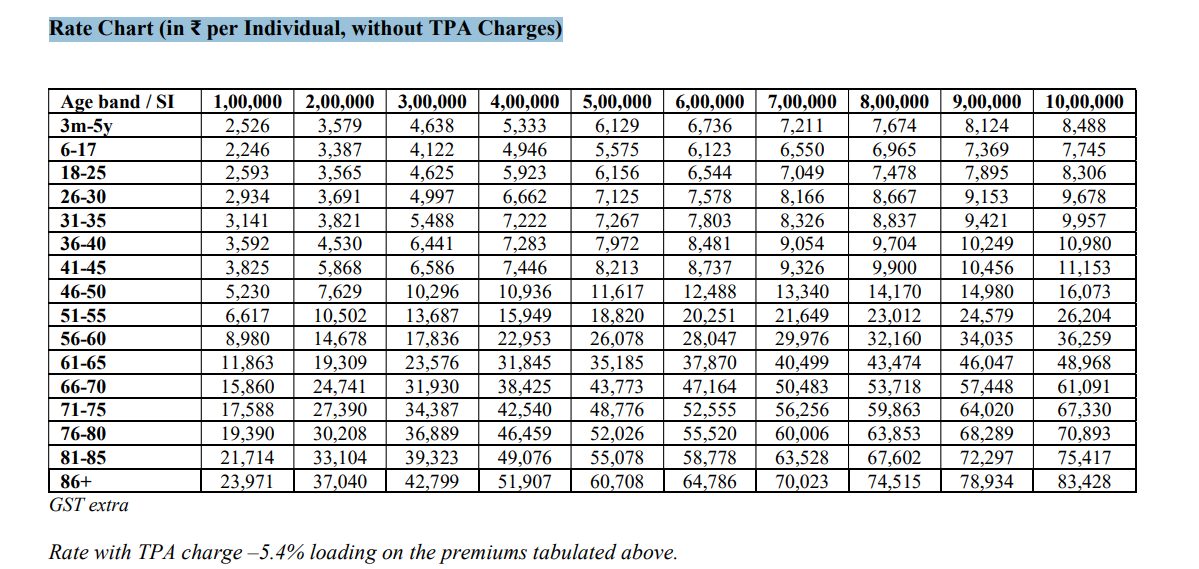
| Are premium charts mandatory? Yes. Health Insurance Regulations require insurers to publish product details, including policy wordings, prospectuses, and premium rates, on their websites. Additionally, if any underwriting loadings are applied beyond the filed premium, insurers must inform the customer in writing and obtain explicit consent before policy issuance. |
How do Premium Prices differ by City or Zone?
In India, health insurers use zonal classifications to price premiums more accurately based on medical costs, lifestyle risks, and healthcare infrastructure in different regions. It's a common practice to ensure that residents or those from non-metro/tier 2/3 cities are not penalized for higher treatment costs in tier 1.
For instance, if a 25-year-old male purchases an HDFC Optima Secure plan with a sum insured of Rs 10 lakh, he needs to pay an annual premium of Rs 13,300 if he resides in Delhi, while he needs to pay Rs 11,210 if he resides in Patna.
Here's an overview of how zonal classification works:
- Zone I (Metro Cities): This zone includes cities such as Mumbai, Delhi, Chennai, Bengaluru, Hyderabad, and Kolkata. Medical and hospitalization costs are highest in these areas, resulting in higher premiums.
- Zone II (Tier 2 Cities): Covers state capitals and large cities such as Pune, Ahmedabad, Jaipur, Lucknow, and Kochi. Healthcare costs are moderate in these areas, which means the premiums are slightly lower.
- Zone III (Rest of India / Tier 3 & Rural Areas): This zone includes smaller towns and rural regions, where treatment costs are comparatively lower, resulting in more affordable premiums.
National Insurance offers zonal classification for some of its health products depending on the following zones:
| Plan | Classifications based on policy discounts and T&C |
|---|---|
| National Senior Citizen Mediclaim Policy | Zone 1 - Gujarat, Delhi & NCR, Hyderabad, Mumbai & Mumbai Suburban, Thane and Navi Mumbai Nagpur, Pune Zone 2 - Rest of India |
| New National Parivar Mediclaim Policy | Zone 1 - Greater Mumbai Metropolitan area, entire state of Gujarat, Delhi, NCR, Chandigarh, Pune Zone 2 - Chennai, Hyderabad, Bangalore Zone 3 - Rest of India |
| National Parivar Mediclaim Plus Policy | Zone 1 - (Greater Mumbai Metropolitan area, Gujarat) Zone 2- National Capital Territory (NCT) Delhi and National Capital Region ( NCR), Chandigarh, Pune Zone 3 - Chennai, Hyderabad, Bangalore, Kolkata Zone 4- Rest of India |
Insurers often apply a zonal copayment when you receive treatment in a higher zone than the one for which your premium is priced.
For instance, the National Parivar Mediclaim Plus Policy has the following conditions:
- Zone I Premium: No copay in other Zones
- Zone II Premium: No copay in Zones II–IV; 5% copay in Zone I.
- Zone III Premium: No copay in Zones III–IV; 7.5% in Zone II, 12.5% in Zone I.
- Zone IV Premium: No copay in Zone IV; 10% in Zone III, 17.5% in Zone II, 22.5% in Zone I.
How to Calculate Your Premium ?
Calculating your health insurance premium with National Insurance Company Limited (NICL) is simple once you know the key factors involved. Here’s how it works:
1) Step 1: Know Your Age Band
Premiums under the National Mediclaim Policy are grouped by age bands — such as 18–25, 26–35, 36–45, and so on.
The older you are, the higher the premium, since health risks rise with age. We recommend our customers to buy a healthy plan when they are young and healthy. Starting early helps you complete waiting periods sooner, benefiting your long-term coverage.
2) Step 2: Choose the Sum Insured
Decide the total coverage amount you need (for example, ₹2 lakh, ₹5 lakh, or ₹10 lakh).
A higher sum insured offers better protection but comes with a slightly higher premium (increase is not linear)
3) Step 3: Check Your Zone
Premiums also vary based on where you live. NICL classifies India into zones to reflect medical costs:
- Zone 1: Metro cities – higher premiums
- Zone 2 & 3: Tier-II and Tier-III cities – moderate or lower premiums
Note: At Ditto, we recommend checking for zonal restrictions, such as copays. If your budget allows, consider choosing Zone 1/Tier-1 premiums, even if you live in lower zones, to ensure coverage for treatments in major cities or specialized hospitals without incurring extra costs.
4) Step 4: Add Optional Covers
You can enhance your base policy with add-ons like critical illness, maternity benefit, or daily cash allowance.
Each add-on increases your total premium slightly but expands coverage.
Here’s a snippet from National Parivar Mediclaim Plus Policy about optional covers:
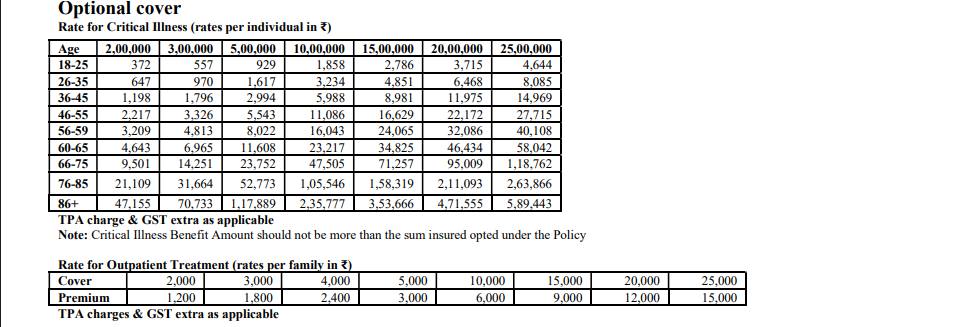
5) Step 5: Apply available discounts
NICL offers discounts for:
- Family floater policies
- co-payment facilities
- No-Claim Bonus (NCB) for claim-free years
For instance, most NICL health products, such as the National Mediclaim Policy and the National Senior Citizen Mediclaim Policy, offer a 10% Online discount (without intermediary) during purchase.
| Quick Note: Final premiums depend on the insurer's underwriting of your medical history. In essence, loading charges adjust the cost of insurance to make it actuarially sound. At the same time, PED provisions control the extent and timing of coverage for existing medical issues, together ensuring both affordability for the pool and fairness for individual risk levels. |
How are premiums for family floater plans calculated?
Let's take the example of National Parivar Mediclaim Plus Policy (Floater Policy):
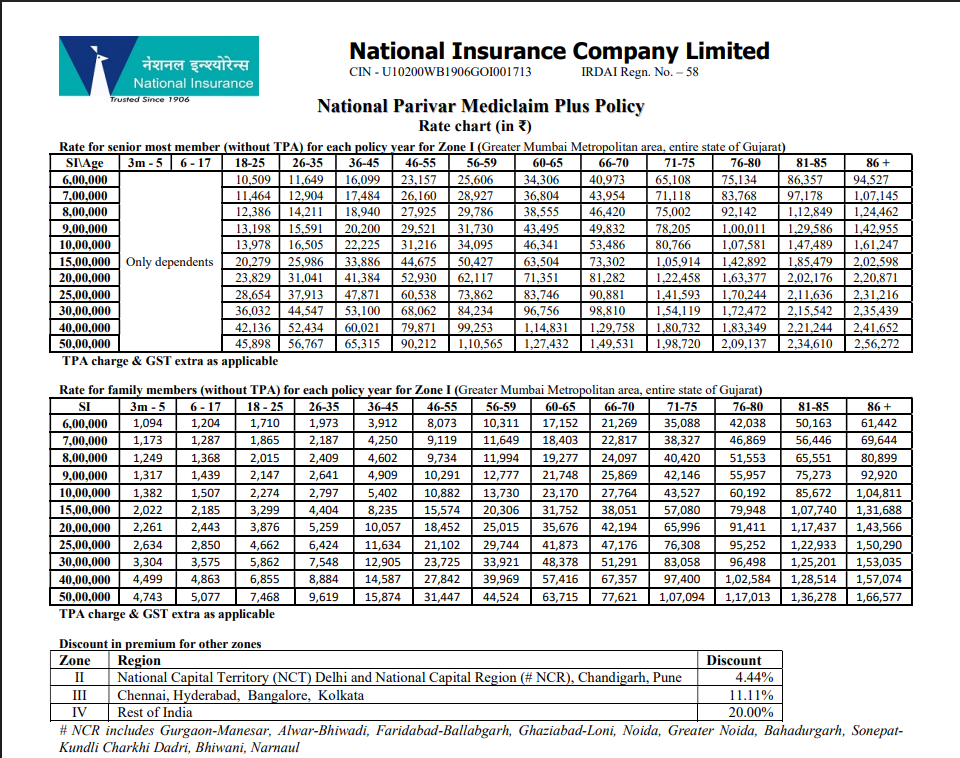
Under this policy, the total family floater premium is calculated by adding the premium of the oldest insured member to the combined premiums of all other covered family members.
Each figure is drawn from the corresponding Sum Insured (SI) and age band in the two tables from the above extract.
Example (illustrative for Zone I, ₹10 lakh SI):
| Member | Age band | Rate (₹) | Table used |
|---|---|---|---|
| Father | 46-55 | 31,216 | Senior-most |
| Mother | 43 (36-45 band) | 5,402 | Family |
| Child 1 | 15 (6-17 band) | 1,507 | Family |
| Child 2 | 10 (6-17 band) | 1,507 | Family |
- Base premium = 31,216 + 5,402 + 1,507 + 1,507 = ₹ 39,632
- Add 5.4 % TPA loading = ₹ 39,632 +₹ 2,140 = ₹ 41,772
Note: TPA loading is the additional charge on the total premium when the policy is serviced through a Third-Party Administrator, covering the administrative cost of cashless and claims support.
Why Talk to Ditto for Your Health Insurance?
At Ditto, we’ve assisted over 7,00,000 customers with choosing the right insurance policy. Why customers like Arun below love us:

✅No-Spam & No Salesmen
✅Rated 4.9/5 on Google Reviews by 5,000+ happy customers
✅Backed by Zerodha
✅100% Free Consultation
Final Thoughts
Knowing how age, coverage, and location affect your health insurance premium helps you make smarter decisions while purchasing a health plan. Here's what to keep in mind:
- Premiums increase with age as health risks rise. They may also increase when insurers revise rates or adjust for inflation, resulting in updated premium charts.
- Sum insured slabs define coverage levels and potential payouts, enabling insurers to assess risk and determine appropriate premiums accurately.
- Premiums differ by city or zone based on healthcare costs, lifestyle, and infrastructure.
- Loading charges are applied on top of the premiums; most policies also specify the maximum possible loading for any one condition and the policy overall.
- Consider your age band, chosen sum insured, residential zone, optional add-ons, and discounts such as multi-year plans, family floater policies, or No-Claim Bonus.
Still unsure how to go about purchasing a health policy? Book a call with us, and let our experts guide you through the process.
FAQs
How can I quickly find my premium in the rate chart?
Check your age band, zone, and sum insured in the National Insurance premium rate chart to ensure accuracy. The corresponding row shows your annual premium. You can also use NICL’s online premium calculator for a faster estimate.
Alternatively, you can upload the premium rate chart into any AI model with your profile, and it will automatically calculate the premiums.
Why is my premium different from someone else’s?
Premiums depend on age, sum insured, zone (city category), and optional add-on covers. Even with the same plan, variations in age, health, or city can result in different premiums.
What does National Insurance use the zones for?
NICL usually divides India into three zones based on healthcare costs: Zone 1 (metros), Zone 2 (tier-II cities), and Zone 3 (smaller towns). Premiums are higher in metros due to increased treatment costs.
Does my premium increase every year?
Premiums may increase when you move to a higher age band, add additional covers, or when NICL revises rates under IRDAI-approved guidelines due to inflation.
Can I reduce my premium?
Yes. Choosing higher deductibles, a long-term policy, or maintaining a claim-free record can lower premiums. Selecting the correct sum insured and avoiding unnecessary add-ons also helps.
Last updated on:









